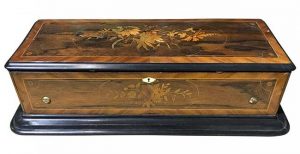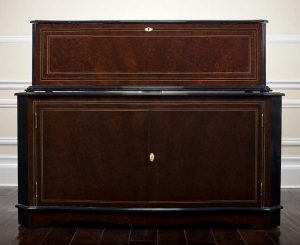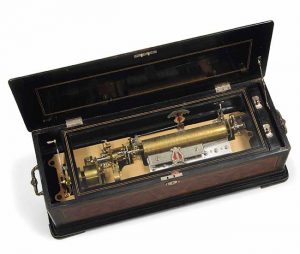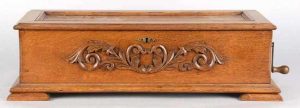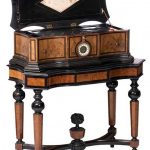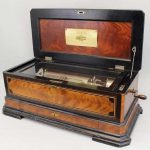An escutcheon is a general term for a decorative plate used to conceal a functioning, non-architectural item. Escutcheon is an Old Norman word derived from the Latin word scutum, meaning a shield. Escutcheons are most often used in conjunction with mechanical, electrical, and plumbing components and fixtures where a pipe, tube, or conduit passes through a wall [or other material] surface. The escutcheon is used to bridge the gap between the outside diameter of the pipe and the inside diameter of the opening in said surface.
An escutcheon can also refer to an item of door furniture. In this case, it is an architectural item that surrounds a keyhole or lock cylinder, and is often part of a lockset. Escutcheons help to protect a lock cylinder from being drilled out or snapped, and to protect the surrounding area from damage and wear from the end of the key when it misses the keyhole. These types of escutcheons are often found on lockable music boxes.
Some escutcheons come in pairs with a plain one to go on the outside of the door while the matching escutcheon inside has a rotating cover to prevent prying eyes. The cover also prevents insects and dust from getting into the house/room. Reference: Wikipedia
LARGE 19TH C. SWEDISH MARQUETRY MUSIC BOX recently cleaned and tuned. Made from rosewood, mahogany, and various wood inlays. Bone key escutcheon. From a fine Dallas estate. 31w x 14d x 9h.
Sold for $1,100 at J. Garrett Auctioneers in 2018
An exhibition-quality ‘Flute Voix-Céleste et Mandoline’ interchangeable cylinder music box-on-stand, by Lecoultre, Circa 1869, No. 37112, with twenty cylinders each playing six airs of a wide selection including large sections of operas, ballads, folk tunes and dances, the massive longe-marché spring motor with helical-geared top-wind folding crank, triple-blade governor with start/stop, the double-section combs each with two rows of screws flanking central 22-key organ, on substantial reeded gilt cast bedplate with the bedplate void revealing the edge of the bellows which are lined with rouge paper with gilt tooled decoration, in ebonised interior with dust lid having pierced spandrels, double shaped lid stays, change/repeat and start/stop controls to right, fully signed double lever-bolt lock bearing the Rue des Alpes 12 address, in very imposing serpentine case, the slightly-domed lid with quadruple tulipwood stringing and intermediates of ebony fields, the whole in deep toned and richly figured thuyawood veneers polished to a fine mirror-shine, bone escutcheon to front locks and the repeated veneers to front, sides and back, standing on the matching console storage stand in serpentine profile, large double doors with repeated stringing opening to reveal the four press slides, with letterbox inlay front and four cylinder storage each, shaped apron below, on integral bracket feet, with the period tunesheet listing seventeen cylinders, now separately framed in its non-restored state (some clear tape and stain marks) – the cabinet 56in. wide, 24in. deep, the cylinders 26.1/4in. and the diameters 3.3/4in.
Sold for US$ 64,050 (£ 51,335) inc. premium at Bonhams in 2010
A SWISS BURR MAPLE AND EBONISED WOOD INTERCHANGEABLE-CYLINDER MUSIC BOX LATE 19TH CENTURY The case with brass handles and bone escutcheon playing one cylinder with six airs, and with two further interchangeable cylinders, with zither attachment 30 ½ in. (77.5 cm.) wide
Sold for GBP 2,250 at Christie’s in 2014
Quarter Sawn Oak Music Box
Nice oak cabinet features a decorative front design and fancy escutcheon with a side hand crank. Condition (Excellent). Size 29″ x 12-1/2″ x 8″
Sold for $1,100 at Dan Morphy Auctions in 2016
